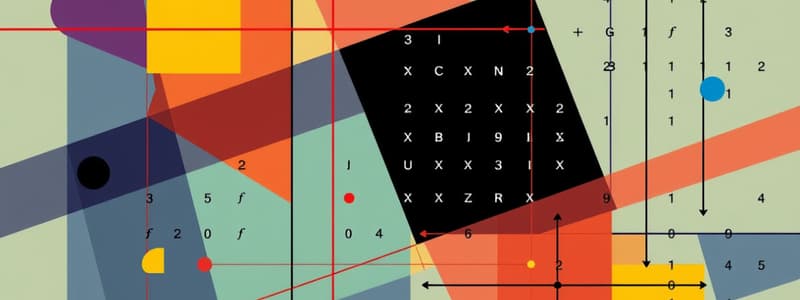Podcast
Questions and Answers
A linear transformation is a special type of function.
A linear transformation is a special type of function.
True (A)
If A is a 3×5 matrix and T is a transformation defined by T(x)=Ax, then the domain of T is ℝ3.
If A is a 3×5 matrix and T is a transformation defined by T(x)=Ax, then the domain of T is ℝ3.
False (B)
If A is an m×n matrix, then the range of the transformation x maps to Ax is ℝ^m.
If A is an m×n matrix, then the range of the transformation x maps to Ax is ℝ^m.
False (B)
Every linear transformation is a matrix transformation.
Every linear transformation is a matrix transformation.
A transformation T is linear if and only if T(c1v1+c2v2)=c1T(v1)+c2T(v2) for all v1 and v2 in the domain of T and for all scalars c1 and c2.
A transformation T is linear if and only if T(c1v1+c2v2)=c1T(v1)+c2T(v2) for all v1 and v2 in the domain of T and for all scalars c1 and c2.
The range of the transformation x Ax is the set of all linear combinations of the columns of A.
The range of the transformation x Ax is the set of all linear combinations of the columns of A.
Every matrix transformation is a linear transformation.
Every matrix transformation is a linear transformation.
If T: R^n -> R^m is a linear transformation and if c is in R^m, then a uniqueness question is 'Is c in the range of T?'
If T: R^n -> R^m is a linear transformation and if c is in R^m, then a uniqueness question is 'Is c in the range of T?'
A linear transformation preserves the operations of vector addition and scalar multiplication.
A linear transformation preserves the operations of vector addition and scalar multiplication.
A linear transformation T: R^n -> R^m always maps the origin of R^n to the origin of R^m.
A linear transformation T: R^n -> R^m always maps the origin of R^n to the origin of R^m.
Flashcards are hidden until you start studying
Study Notes
Linear Transformations
- A linear transformation maps vectors from R^n to ℝ^m, assigning each vector x in R^n to vector T(x) in ℝ^m.
- For a transformation defined by T(x) = Ax, if A is a 3×5 matrix, the domain of T is R^5, not R^3. The input vector x must match the second dimension of matrix A.
Range and Domain
- The range of the transformation x ↦ Ax is not necessarily ℝ^m; instead, it consists of all linear combinations of the columns of matrix A.
- A matrix transformation is a specific type of linear transformation represented as x ↦ Ax, establishing that not all linear transformations are matrix transformations.
Properties of Linear Transformations
- A transformation T is linear if it meets the condition T(c1v1 + c2v2) = c1T(v1) + c2T(v2) for all vectors v1, v2, and scalars c1, c2 in the domain.
- Linear transformations preserve vector addition and scalar multiplication, demonstrated by T(cu + dv) = cT(u) + dT(v).
Specific Characteristics
- The range of the transformation x ↦ Ax includes all linear combinations of the columns of A, confirming a link between the transformation and the structure of matrix A.
- Every matrix transformation is indeed a linear transformation, following the properties of linearity in T.
Existence and Uniqueness Questions
- In context of linear transformations T: R^n → R^m, questioning if a vector c is in the range of T pertains to existence (whether there is an x such that T(x) = c) rather than uniqueness.
Origin Mapping
- A linear transformation T: R^n → R^m guarantees that the origin of R^n (T(0)) is always mapped to the origin of R^m (0), affirming the structure-preserving nature of linear transformations.
Studying That Suits You
Use AI to generate personalized quizzes and flashcards to suit your learning preferences.




